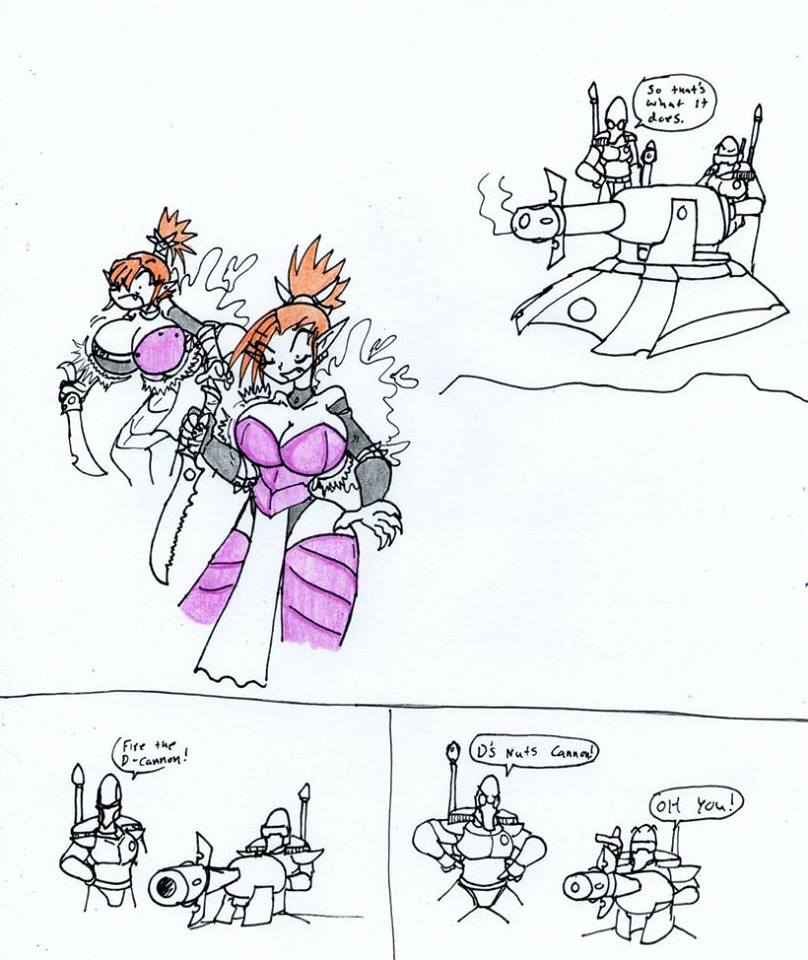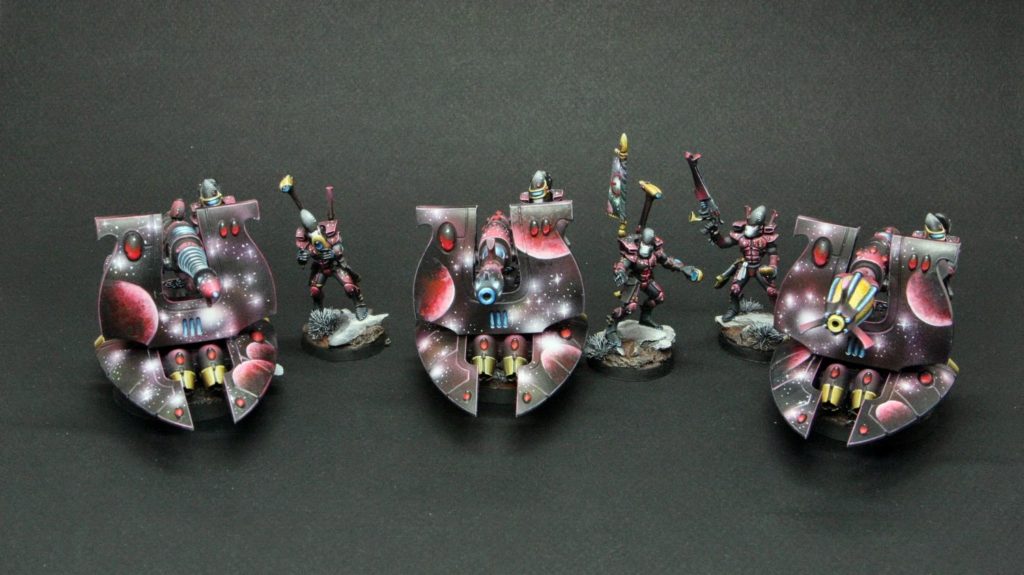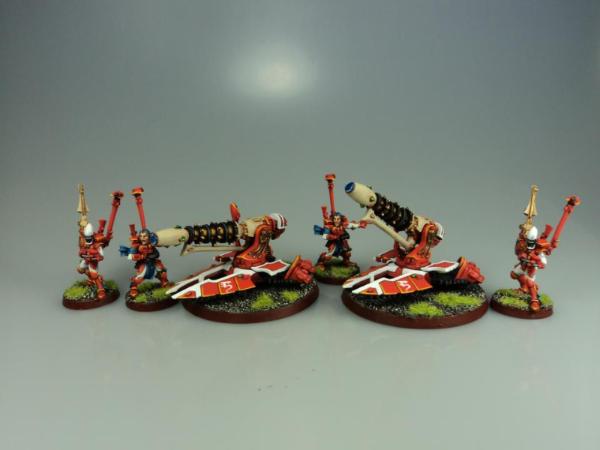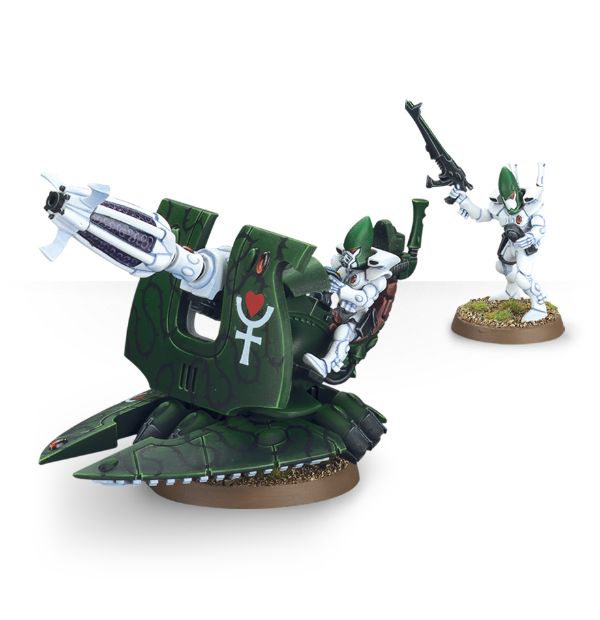Now that they’re not Strength D anymore, people have forgotten about Support Weapons. But in the shadows they still lurk, biding their time until the meta is right to rise again…
Click to read the newly-updated article, or check out the Tactics Corner for more reviews and strategies.
Overview
“Vaul’s Wrath batteries,” as Support Weapon formations are often known as a callback to the days of Eldar myth, are something of an unusual sight on the battlefields; by their nature they are suited best to a static defense position, something that their armies are often loathe to establish for fear that they can be pinned down, trapped, or surrounded by the enemy. However, there are some positions that cannot be abandoned under any circumstances- or that are so inaccessible or defensible that the enemy cannot realistically use them against the Eldar, and in these circumstances a Support Weapon battery may be brought in to provide devastating firepower to turn the tide of a battle.
A Support Weapon squad is something of an odd duck, both in the context of the Craftworlds codex and in the game in general, as it doesn’t follow the rules that many artillery weapons do and has a very unusual profile. The gun and both its crewmembers are treated as a single model with one profile; movement 6″ is surprisingly quick, and in fact it’s a bit surprising that the battery can move much at all. Weapon and ballistic skill 3+ are, of course, standard for an Eldar model, as is strength 3. Toughness 5, however, is quite a bit above the norm and five wounds is no slouch either, though a 4+ save is a bit on the weak side. Two attacks and leadership seven should be wholly irrelevant in the course of the game, as you don’t even take morale and will fold if in close combat regardless. At 37pts with basic loadout, the unit is priced well within reasonable bounds; up to three can be taken per slot, with any mix of weapons.
Also, an interesting tidbit: the Support Weapon kit is one of the very few units in the game that comes innately able to swap between configurations with no magnetization or modification necessary; all three weapons can be hotswapped at will, as they do not need to be glued in (and, indeed, the instructions themselves tell you not to do so.)
Wargear and Special Rules
Support Weapons don’t have a lot of rules; they come with Ancient Doom and Battle Focus, of course, but since their main gun is Heavy they won’t see much use out of either of those. They also have the Support Weapon rule, which means that the squad must be deployed within 6″ of each other when the game starts but act separately after that.
No, the main feature of a Support Weapon is its gun, and it’s the gun we’ll focus on. All Support Weapons come for free with a single Shuriken Catapult (representing the additional crew member not firing the gun),but it’s the platform’s weapon that we really care about- the stock model has a Shadow Weaver (48″ S6 Heavy d6 6s to wound are AP-4, ignores LOS.) Although the random nature of the weapon does it no favors, the cheap price and reasonable durability mean that it can do a pretty reasonable job of sniping away at hidden units on objectives.
The second weapon option is the D-Cannon, which some may remember from 7E when it was one of the many Str D weapons available to Eldar; it’s no longer that absurd, but still has a very strong profile with 24″ range, S12, AP-4, Dmg d6, and Heavy d3 as well as ignoring line of sight. Although a bit short-ranged, the D-Cannon can be a major threat to heavy targets and it has the potential to destroy almost any vehicle in a single volley. At 70pts total, the D-Cannon feels rather pricey compared to the other two, but certainly has its advantages.
The last and most confusing weapon is the Vibrocannon, and it… is a doozy. Not necessarily because of power level, but because of the pile of rules associated with it. The basic profile is pretty simple- 48″, S7, AP-1, Dmg2, and Heavy d3; an Autocannon, in short. However, every Vibrocannon fired at the target adds +1 to wound and -1 to AP for all subsequent Vibrocannons, up to a maximum of +2 to wound and -3 total AP. If the unit suffers any damage from the Vibrocannon, they also are prohibited from advancing in their following turn unless they have the Fly keyword, which adds a bit more utility to the weapon; 40pts per model for this loadout is quite cheap both in an absolute sense and also for such a high-usefulness weapon.
Uses
Support Weapons, as already mentioned, hold a very odd role in a Craftworlds army. While they certainly are no stranger to static firing platforms (e.g. Fire Prisms, ) or backfield units, Support Weapons’ statline make them an awkward unit in a lot of ways. They are small enough that they are vulnerable to anti-infantry guns (especially the S5/6 variety), but also large enough that they can draw fire from heavier guns as well without those being completely wasted on them- indeed, the possibility of a Lascannon or Missile Launcher one-shotting a Support Platform should be a significant concern when using them.
However, two of the three types of Support Weapon have the advantage of not needing line of sight, a fact that you should absolutely take advantage of. Shadow Weavers have it easiest, as their long range means that they can probably just sit somewhere in your backfield behind a ruin and plink away at those scoring units that try to hop onto an isolated objective. Like IG Mortar squads, their job is basically to hold down your home objectives while denying the enemy the easy ability to score objectives of their own; the threat of a couple Shadow Weavers mean that no single basic squad can really have much assurance of holding an objective, forcing your opponent to commit additional resources to scoring victory points that they may not be able to easily spare.
D-Cannons usually have to work a bit harder and put themselves at more risk in a lot of matchups; with only 24″ of range, they will usually need to move forward into midfield in order to reach the targets that they want to be hitting- though there is a certain value to simply having them act as area denial units that prevent the enemy from moving their heavier units forward over the course of the game as well. Aggressive/short-ranged armies such as Tyranids or Blood Angels also may allow you to sit still where you are while pounding important targets, though the flip side of this is that they will probably be up in your face enough that they can threaten the unit with assaults that they absolutely do not want to be a part of.
Vibrocannons, however, have to contend with finding themselves a good firing point that also offers them reasonable protection; as they are not infantry they cannot get into the upper levels of ruins, but it’s not implausible to find them a spot where they can manage cover (for that vital 3+ armor) while still getting to shoot. Range is the main defense that will keep a Vibrocannon battery safe, as their 48″ reach can put them beyond the threat radius of many enemy guns and the Alaitoc bonus will help mitigate the worst of enemy firepower. Note that unlike the other two, Vibrocannons really want to be fielded in significant numbers- the more of them you have, the more bonuses you can stack up, and a weapon that wounds on 2s with AP-3 and d3 shots is no joke for most vehicles and the like. The ability to deny enemies the opportunity to advantage can also be extremely strong; some units, like Genestealers, are extremely reliant on advancing to do their main job, and pinning down a unit that is racing for an objective can similarly be game-winning. There is something to be said for including one or two Vibrocannons as tech against such armies, but I don’t think it’s really worth it overall- though perhaps someone cleverer than I will come up with a list that really makes use of it.
Support Weapons also benefit from a stratagem unique to them, although it is definitely not as exciting as it could be. Vaul’s Might costs 1CP and lets you pick two Support Weapons within 6″ of each other; since this is the maximum distance members of a pseudosquad can be deployed from each other, this should be a fairly trivial requirement. For the remainder of the phase, those two models both reroll results of ‘1’ to woun- definitely a nice bonus, but since it only applies to wound rolls and only to two models, it definitely doesn’t feel particularly impressive.
If you’re considering including Support Weapons in an army, the main question you need to consider is what kind of role you want them to play (and whether another unit might fill that role better- Craftworlds have no lack of excellent shooting platforms, after all.) Shadow Weavers compare favorably to the Night Spinner overall, being both cheaper and easier to hide, not to mention having superior numbers against anything that isn’t two wounds. They are, as mentioned earlier, best suited to being “sniper” units that harry enemy infantry trying to hold objectives and can fill a solid job of hiding on your own backfield objectives out of sight while doing so. D-Cannons, on the other hand, should be brought in if you’re worried about tough midfield/aggressive units like transports, Knights, Tyranid monsters, etc- their ability to remain hidden from most threats while being quite dangerous themselves is a big advantage, but you need to have enough midfield support (and especially melee support) of your own so that the enemy doesn’t just close in with them and kill them. Vibrocannons are the most “traditional” of the three weapons in their use- they want to sit back along board edges and blast away at enemies from a safe position, which means that the rest of your list really needs to have enough forward presence to make sure you are still scoring points. They also are heavily inclined towards focusing their fire on a single multiwound target (like a tank, monster, or even just a big unit of Primaris marines) due to the way their bonuses stack up. If you’re going to bring Vibrocannons, you probably want to bring quite a lot of them- I would rarely field less than four, and probably more like six or nine.

Countering
We’ve highlighted a few of the Support Weapon’s weaknesses already, but it’s good to reiterate them. Each of the three versions has a major limitation on what it can do- Shadow Weavers are all but helpless against T7+ targets as well as anything with multiple wounds and a good armor save- and they are, in general, a very unreliable weapon, requiring as they do high results on the d6 not just for number of shots but also in order to have any kind of armor penetration at all. D-Cannons are incredibly short-ranged and are thus vulnerable to anything that can get in close and hit them hard, but it’s also worth remembering that their super-impressive statline is often wasted against a lot of kinds of targets- S12 will only affect T6 or lower vehicles in any meaningful way and AP-4 is pointless in the face of anything with an invuln. Vibrocannons can be treated exactly like any other heavy weapon unit (Devastators, etc) in the game- counterfire from your own heavy weapons or some reserve units dropping in unpleasantly close with both do a number on them.
Final Thoughts
Support Weapons aren’t one of the more eye-catching units from the Craftworlds book, but that’s probably a bit unfair to them as there are so many powerful units to compete with they are hard-pressed to find a place in competitive lists. However, if you are looking for an unusual niche solution or want to try out some more esoteric units from the book, I would definitely recommend them to you- you’d be surprised at what a battery of them can do to most targets while coming in significantly below the price of most comparable options.
As always, remember you can buy your wargaming supplies from the Frontline Gaming store at great discounts every day, whether you’re looking to start a new army or expand an existing one.






I used to use a trio of shadow weavers all the time but they’re just too weak now that they fire D6 and don’t wound T4 on 2+. It works for guard mortars because they’re so cheap, which these are not. At least a native AP-1 would have been nice.
D-cannons and vibro cannons are more appealing, though as said a vibro cannon needs LoS which can be difficult from so far away.
I’m looling forward to playing around with the two options though.
I still use 2 Shadow Weavers on occasion. They’re cheap Heavy choices to open up the Brigade. However, most Eldar players don’t play a Birgade like I do so they don’t always have the need for 3 Heaves. And I often find the War Walker is better for the ability to go after objectives.
Yeah, when I do Craftworld brigades (which is not always, especially with battalions getting so much better, but still sometimes) I find that there area lot of units that often offer more utility in the slot. Dark Reapers obviously are still excellent, and though more expensive they have a superior indirect-fire option while also having great anti-tank. War Walkers can reach into the enemy backfield while being more flexible and mobile, and Wraithlords can hold your own backfield more reliably. And Fire Prisms are your luxury option, being good enough to make top lists pretty regularly and have amazingly versatile firepower.
Bottom line, the Support Weapon isn’t awful, but it definitely isn’t great, either. I think the D-Cannon is maybe the one with the most potential, but even it is probably not what you want most of the time.
Yeah, I agree. They’re certainly not bad suffer form the Eldar problem: too many good choices.
What makes me sad about these is that if you had the *option* of keeping three as a unit rather than having to split them they’d probably be borderline competitive – they’d be a great target for guide, and would get a lot of benefit from having the guardian tag, and thus being eligible for using “Celestial Shield”. As three separate units they’re not efficient to buff and give away kills too easily.
Yeah, I don’t like how artillery break up into separate units, either.
For sure. The fact that the stratagem that is specifically for them and only them _also_ only hits two models is even more balls, because you would think that if anything got around the issue it would at least be the incredibly-narrow stratagem with very limited bonuses.
The stratagem always confuses me.
They’re always depicted in groups of three… yet their stratagem only effects two? Why not just have it effect three? It would hardly be game-breaking.
Having the custom craft-world attribute that gives 1 reroll to hit and wound per unit (I think it’s master-crafted weapons?) actually leverages this really well. With vibrocannons, once you get them humming on the same target. You’re hitting on 3+ and wounding on 2+, meaning you’re unlikely to fail more than one of either of those roles. (Especially with only D3 attacks). Plus, it allows for optimal splitting of Vibrocannon fire, in case you finish of the primary target.
For what it’s worth, the CA changes and the PA book mean that review is quite out of date. Now Vibro Cannon are a largely defensible choice.
Little known fact, Support Weapons have the GUARDIAN keyword so you can give them a 4+ invuln with the Celestial Shield stratagem and if they are Ulthwe you can use their faction stratagem to give one +1 to hit. Still probably not enough to make them good, but interesting at least.
Yes. This is hugely important. Suddenly for the first one they target, the opponent needs to be planning to dump a significant amount of fire to kill. A 4++ with 5w can take a hemlock to the face and probably survive.
And, especially for vibrocannons, thinking of them as a single large unit gives a very different perspective. A fire prism that loses 6 wounds is at bs4. After 10 its BS5. I battery of vibrocannon support weapons that loses 10 wounds is down 2d3 shots, but those remaining shots hit just as hard.
It’s an interesting quirk, although I wouldn’t use it a lot, as Eldar tend to have better places to spend their CP. However, if it can deny your enemy their kill that turn, or if it keeps something critical alive, it’s definitely not worthless.
Losing models and degrading stats are GW’s attempt to make single-model and multimodel units function more like each other on the table; it mostly does the job, so I think the distinction between the two is often fairly minimal. Multimodel units do have the advantage of sometimes being able to force an opponent to “waste” damage on them, though.
Cheapest way to fill out a battalion, which is very doable now a days. There are if you min (improve where wanted) 48 pnt Troops (Storm Guardians), 63 pnt Elites (Striking Scorpions, not that Banshees are much more) and 54 pnt Fast Attacks (3 Man unit Twin-Catapult Windriders) and 37 pnt Heavy (Support Weapon). That is a min of 750 pnts before you add HQs and unit/weapon upgrades to flavor.
Scorpions are actually 55pts base, although giving the exarch a weapon upgrade is often useful.
But yeah, you can make a brigade suprisingly cheap for Craftworlds. Of course, some of those units I would say are very much worth spending 10-15pts more to get something that is a lot more functional (e.g. Hawks instead of Windriders), but in the broad sense it really showcases that Craftworlds have a lot of options to minimize their slots if they need to.
Yeah I was doing the points from memory and I just always take the scorpion’s claw on the exarch. As for the hawks, I would say maybe, I can think of many instances where I would rather have the cheaper bikes. So the min would be 726 pnts plus HQs.
Just realised today the Codex says ‘any’ model in the unit can change weapon, so you can have mixed batteries, though you probably wouldn’t want to due to range differences / differing battlefield roles etc.
It is an option that you will occasionally use, mainly to take a Shadow Weaver in place of one of the guns in the batter for points reasons. The Weaver’s long range and option to deploy out of LoS mean that it can be fairly flexible about where it goes compared to the others.